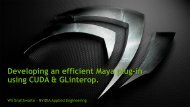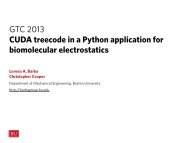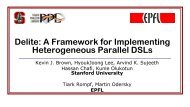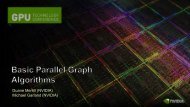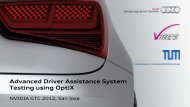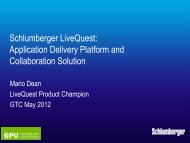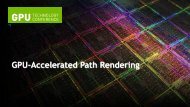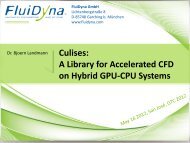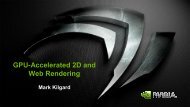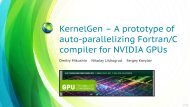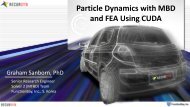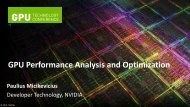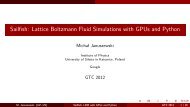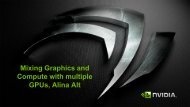GTC 2012 Program Guide - GPU Technology Conference
GTC 2012 Program Guide - GPU Technology Conference
GTC 2012 Program Guide - GPU Technology Conference
Create successful ePaper yourself
Turn your PDF publications into a flip-book with our unique Google optimized e-Paper software.
TUESDAY<br />
present an efficient method for directly tessellating NURBS<br />
surfaces using the NVIDIA CUDA computing API.<br />
Speaker(s): Brent Oster (Applied Engineer, NVIDIA)<br />
Topic(s): Computer Graphics (Advanced)<br />
TUESDAY, MAY 15, 15:00 (50 MINUTES)<br />
ROOM A3<br />
S0407 A High Level <strong>Program</strong>ming Environment for<br />
Accelerated Computing<br />
One of the critical hurdles for the widespread adoption of accelerated<br />
computing in HPC is programming difficulty. Users need a simple<br />
programming model that is portable and is not significantly different<br />
from the approaches used on current multi-core x86 processors. In<br />
this talk I will present Cray’s strategy to accelerator programming,<br />
which is based on a high level programming environment with tightly<br />
coupled compilers, libraries, and tools. Ease of use is possible with<br />
compiler making it feasible for users to write applications in Fortran,<br />
C, C++, tools to help users port and optimize for accelerators, and<br />
auto-tuned scientific libraries.<br />
Speaker(s): Luiz DeRose (Director of <strong>Program</strong>ming Environment,<br />
Cray Inc.)<br />
Topic(s): Development Tools & Libraries, Parallel <strong>Program</strong>ming<br />
Languages & Compilers (Intermediate)<br />
TUESDAY, MAY 15, 15:00 (50 MINUTES)<br />
ROOM A5<br />
S0413 Delivering 3D Professional Graphics from the<br />
Cloud with Citrix XenDesktop<br />
Recent technological advances have made it practical to deliver<br />
3D professional graphics applications from the Cloud (private or<br />
public) with a high quality user experience and at an attractive<br />
cost. Organizations can keep their intellectual property safe in the<br />
data center since only fully-rendered screen images are sent over<br />
the network. Users in remote locations no longer have to wait for<br />
large file transfers. And they can access 3D models from a wide<br />
variety of devices, including iPads and Android tablets. Learn how<br />
Citrix XenDesktop, XenServer and Receiver technologies have<br />
made all of this a reality for many organizations today.<br />
Speaker(s): Derek Thorslund (Director of Product Management, Citrix<br />
Systems, Inc.)<br />
Topic(s): Cloud Computing, Computer Graphics, Visualization (Beginner)<br />
TUESDAY, MAY 15, 15:00 (25 MINUTES)<br />
ROOM A7<br />
S0436 Integrated <strong>GPU</strong> Acceleration With Real Time<br />
Visualization Of Terabyte Data<br />
Computation and visualization doesn’t necessarily have to act as<br />
two separate entities. This talk explains the integration of real-time<br />
compute with real-time visualization. Industry and academia have<br />
provided attractive solutions for compiler-directive optimized code<br />
for computations. To support cases that involves massive yet ad-hoc<br />
data I/O and computation with interactive visualization, Hue<br />
developed a different model which bridges the gap between<br />
“complete system rewrite” and “compiler directive optimized code”.<br />
The talk explains how highly optimized data I/O mechanisms<br />
coupled with predefined input and output definitions for kernels<br />
provide excellent scalability and interactivity during runtime.<br />
Speaker(s): Kelly Walker (Senior Software Developer, Hue)<br />
Topic(s): Visualization, Energy Exploration (Beginner)<br />
TUESDAY, MAY 15, 15:00 (25 MINUTES)<br />
ROOM B<br />
S0611 Edge-Aware Shaders for Real-Time<br />
Computer Graphics<br />
The most common approach in rendering is to define behavior at a<br />
point in terms of material properties and incident illumination.<br />
That approach works well when the geometry and material<br />
properties are well-known, and the light physics are simulated<br />
accurately. We present a technique to help situations where the<br />
model and/or physics is incomplete. This technique augments<br />
shaders with information about nearby edges, such as corners<br />
and boundaries between materials, and makes it natural to add<br />
richness procedurally near these visually critical regions.<br />
Speaker(s): Peter-Pike Sloan (Principal Research Scientist, NVIDIA)<br />
Topic(s): Computer Graphics (Intermediate)<br />
TUESDAY, MAY 15, 15:00 (50 MINUTES)<br />
ROOM M<br />
S0620 VSIPL++: A High-Level <strong>Program</strong>ming Model<br />
for Productivity and Performance (Presented by<br />
Mentor Graphics)<br />
Learn how VSIPL++ can improve your productivity and provide<br />
software portability, without sacrificing performance. We will<br />
describe how VSIPL++’s open-standard high-level programming<br />
model addresses the challenges of writing high-performance<br />
embedded software on GP-<strong>GPU</strong>s and other heterogeneous<br />
hardware, using advanced C++ techniques and data abstraction –<br />
and how we make this work in the real world. We will also present<br />
a comparison of performance results from various configurations<br />
of CPU and GP-<strong>GPU</strong> processing engines for a signal processing<br />
application developed using VSIPL++.<br />
Speaker(s): Brooks Moses, Ph.D. (Sourcerer, Mentor<br />
Graphics Corporation)<br />
Topic(s): Supercomputing (Beginner)<br />
TUESDAY, MAY 15, 15:00 (25 MINUTES)<br />
ROOM A2<br />
S0625 S3D Direct Numerical Simulation - Preparations<br />
for the 10-100PF Era<br />
The evolution of supercomputing into the mid-petaflop era has<br />
been typified by heterogenous compute nodes with the majority of<br />
the compute capability delivered by a large number of lightweight<br />
cores. In order to prepare for the extension of this trend, the DNS<br />
code S3D has been retooled in anticipation of a target architecture<br />
offering 10s of thousands of heterogeneous nodes containing many<br />
X86 cores as well as <strong>GPU</strong> derived accelerators. Movement of outer<br />
loops to the highest level in the code facilitates hybrid MPI-OpenMP<br />
performance and an elegant path to accelerated kernels using<br />
OpenACC. It is anticipated that relevant scientific simulations at this<br />
scale will have a per-node footprint that can be contained entirely<br />
on the accelerator, so provision is made to maintain primary<br />
solution variables in accelerator memory with specific regions<br />
moved to the CPU for inter-node communication and workload<br />
balancing. With the current performance it is estimated that the<br />
new code will make it possible to meet early science goals with the<br />
full build-out of the anticipated Titan system as well as provide a<br />
platform to transition into the exascale software research space.<br />
Speaker(s): Ray Grout (National Renewable Energy Laboratory)<br />
Topic(s): Supercomputing (Beginner)



